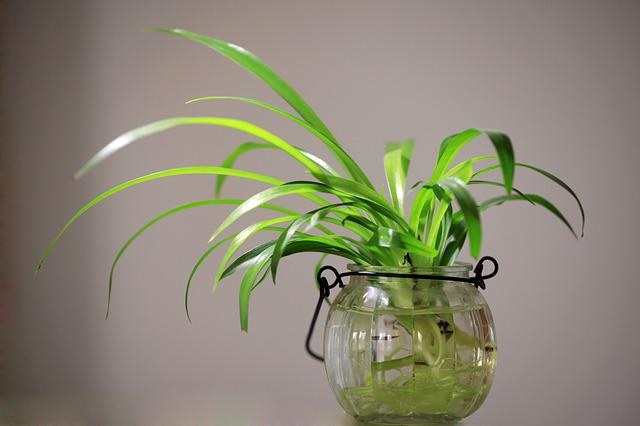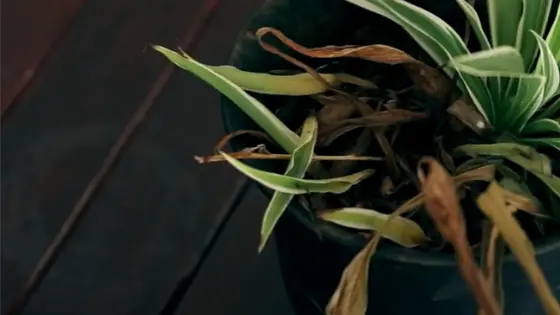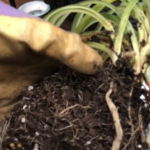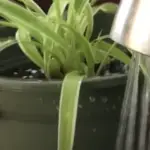A sixth sense, or the ability to feel that something is off? That’s a superpower we wish we had, and it’s one you can attain simply by taking a closer look at your spider plant. You’ll want to know when your spider plant is overwatered in order to properly care for it. By using this simple guide on how to tell if a spider plant is overwatered, you’ll be able to take care of your indoor plant efficiently.
Table of Contents
How Can You Tell If A Spider Plant Is Overwatered?
A spider plant that has been overwatered typically appears malnourished, discolored, and nearly dead. You could find some brown patches, some yellow leaves, and some brown tips on the leaves. There is also a possibility that the leaves may become withered, mushy, and curled.
It is possible to see evidence of root rot on the bottom of the plant if it has been overwatered to a severe degree. In addition to this, you will immediately be greeted with the distinct and unpleasant odor of root rot.
If you look at the soil surface, you will notice that it is darker, with mold and dead plant detritus on top.
Read more: Why Is My Spider Plant Pale And Limp?
Overwatered Spider Plant Symptoms

A spider plant may survive under conditions that are considered to be extremely severe. It can withstand poor light, infertile soil, neglect, and desert-like circumstances. However, if you give your spider plant an excessive amount of water, it will die.
Here are some frequent warning signals to look for so you can begin your rescue effort before it’s too late:
The Yellowing of the Leaves
The foliage of your spider plant will turn pale or light green when you initially overwater it. It won’t be long until the leaves begin to turn yellow because of this. The problem begins with the bottom leaves of your plant.
If you continue to overwater a plant without taking any corrective action, a significant percentage of the leaves will turn yellow, get wilted, and fall off. This is typically a sign of extensive root rot brought on by waterlogging and over-watering of the plant.
However, you must be aware that there are a broad variety of additional factors that might cause the leaves of the spider plant to become yellow. Mineral deposits, edema, bug infestations, illnesses, sunburn, nutrition deficiencies, and even underwatering are all possibilities that need to be ruled out before proceeding.
Read more: How Do You Bring A Spider Plant Back To Life?
Moldy, wet, and soggy soil
Check the soil promptly if you observe unusual leaf yellowing. Overwatered soil is generally overly moist, soggy, and waterlogged. If this is allowed to continue unchecked, it will drown and destroy the roots, in addition to providing an ideal environment for the growth of lethal root rot.
Because it has been wet for a long time, fungi will also start to grow. On the soil, you could find some spores of mold, mildew, and other kinds of fungi.
Leaves That Are Fluffy Or Soft
In addition to becoming yellow, the foliage and stems of a spider plant that has been overwatered will exhibit indications of edema. You could see spots that are mushy, water-soaked, and squishy. Most of the time, the foliage and stems will look puffy or swollen.
Leaves with Brown Spots
If you look closely at the leaves of your spider plant and see brown stains, you should reduce the amount of water that it receives. The spots will first appear as very small rusty specks, but they will eventually grow into huge brown blotches. They may have a golden halo around them and appear to be drenched in water.
Leaves wilting
The degree of the overwatering will determine both the pattern and the extent of the wilting that occurs. The leaves will begin to wilt if you continue to water the plant without first allowing the soil to have a chance to dry out. The leaves that have withered are floppy, puffy, and mushy.
Wilting occurs when an excessive amount of water causes the air pocket in the soil to get filled. This results in the roots being waterlogged, which leads to the development of root rot. As a result, the root system is unable to absorb water adequately, causing the leaves to wilt.
Read more: Why Are My Spider Plant Leaves Creasing?
Dropping Leaves
You probably already know this if you’re a gardener, but when leaves become older, they fall off naturally. It clears the way for the plant to produce new leaves at a later time. When the issue is excessive watering, the leaves, both old and young, will fall off the plant practically all at once.
Mushy and Shriveled Appearance
The spider plant as a whole will seem mushy and shriveled. This is caused to edema, rot, and tissue damage causing softening and puffing of leaves, stems, and other plant components.
Root Rot
One of the most revealing symptoms of waterlogging is the presence of fungal infection. This occurs when excessive water fills air gaps in the soil, drowning the roots. Roots that are diseased, particularly fungal infections and other illnesses that induce rot, are more likely to attract weak and dead roots.
Roots that have been infected will have a dark brown or black appearance and will feel mushy and squishy to the touch. They quickly fall off and emit a rotten odour comparable to that of a sewer.
Read more: Should I Cut The Dead Tips Off My Spider Plant?
Curling Spider Plant Leaves
When a spider plant receives an excessive amount of water, the leaves may shrink, curl, and become wrinkled. This is because the root system has been damaged, which prevents it from absorbing sufficient amounts of water.
Leaf Edge Browning
Overwatering can cause brown tips on the leaves. Water is pushed to the edges and tips of a spider plant’s leaves. In addition, if you overwater your plant, the veins will break, which will ultimately cause the plant to become brown.
Pest Infestation
Warm and moist environments are ideal breeding grounds for a wide variety of insects, including mealybugs, scale, whiteflies, aphids, and fungus gnats. As a result, the presence of pests on the leaves, particularly on the underside, is an indicator that the plant has received an excessive amount of water.
Spider Plant: Underwatered or Overwatered?
It’s possible for an overwatered spider plant to look nearly identical to one that’s been under water. For this reason, it is absolutely necessary to be aware of the differences that exist between the two. If you keep watering a plant that has already received an excessive amount of water, you are asking for additional difficulty, or even worse, you run the chance of killing your plant.
- The Soil: Everything begins with potting soil. If you overwater your spider plant, the soil will become black in appearance and will have a moist or soggy texture when you touch it. On the surface of the soil, you might see some mold, mildew, or other types of fungal development. A plant that receives insufficient water, on the other hand, will have soil that is dry and loose.
- The foliage: This condition can cause the leaves to become yellow, wilt, and fall off. Both of these outcomes are possible. On the other hand, if the problem is caused by overwatering, the wilted leaves will have a soft and puffy or mushy texture. The leaves of underwater spider plants are brittle and usually rather dry.
- Leaf tips: Spider plants that are submerged in water grow brown leaf tips and edges before they yellow. Yellowing of the leaves and browning of the leaf tips are both symptoms that result from overwatering.
- Stems: When underwatered, the lowest leaves and stems coiled and yellowed first. Overwatering causes the plant’s lowest sections to become soft, weak, and mushy (signs of rot).
- Leaves dropping: As a result of overwatering, both new and old leaves will begin to drop. New leaves can’t grow if the plant is always underwatered. Old leaves and blossoms may also begin to fall off.
How to Properly Water a Spider Plant

Watering Guidelines
To reduce leaf wetness, avoid overhead watering while watering from the top. Water very first thing in the morning or very last thing at night. Check the moisture content of the soil once every four to five days, and do not water it again until it has dried out slightly.
Use a watering tray or saucer that is loaded with stones when you water your plants from below. Allow the soil to absorb water to the point where it is continually wet. Remember that you need to get rid of any surplus water.
Read more: Why Is My Spider Plant Turning Brown After Repotting?
How Often to Water Your Spider Plant?
Watering should be increased during active growth periods. This may take place in the spring, summer, during the blossoming period, or even when the plant is still young. However, you shouldn’t water the soil until the top inch or so has dried up a little bit.
Watering should be reduced throughout the dormant season. This is more common during the winter and other cooler months.
Factors Affecting the Frequency of Watering
The frequency with which you water your spider plant is determined by a number of variables. These factors include the temperature, the humidity, the drainage capacity of the pot material, the size and kind of the pot, and the season.
What Type of Water Does a Spider Plant Require?
You may use water that has been distilled or filtered. In light of this, you might want to consider purchasing a low-capacity water filtering device. Rainwater can also be collected and used for irrigation purposes.
When to water a repotted spider plant?
This will be determined by the level of damage that was sustained. The new growth should become visible after approximately 10 days have passed. However, you must wait until the top inch of the soil has slightly dried up before watering again.
Read more: How Do You Revive A Dying Spider Plant?
How to Treat an Overwatered Spider Plant That Doesn’t Have Root Rot
In the event that your spider plant is exhibiting obvious symptoms of being overwatered, Brown patches, yellowing, withering, curling, etc. If you have determined that your spider plant is not suffering from root rot, then the following are some actions you should take to nurse it back to good health:
- Check the drainage again: the container that your spider plant is growing in should have holes in it for drainage, as this will enable any extra moisture to escape. If there are fewer of them, you should drill more holes.
- Tilt the pot – This allows excess moisture to evaporate and creates more air pockets for healthy root development. You may also promote aeration by poking a few holes into the damp soil with a splinter, a chopstick, or a pencil. This will help distribute the water and air throughout the soil.
- Cut some leaves — Pay attention to the foliage on the top of your spider plant, as well as the blooms, plantlets, and buds. This allows your plant’s energy to be redirected toward rehabilitation and healing.
- Put off fertilizing until you see evidence of lush new growth, and do not resume adding fertilizer until then. Even so, you should only apply the water-soluble fertilizer for ordinary horticultural use once throughout the spring.
- Misting – To restore the damage, spray wilting leaves regularly.
- Dry out the soil. To speed up the process, you can move the whole plant to a place with more light, less humidity, and a higher temperature.
- Dehumidification — Another option available to you is to make use of a dehumidifier. Use a Peltier dehumidifier instead of a desiccating model.
- Repot – There is a reward for repotting your spider plant in fresh potting mix whenever it is necessary. This is enormously beneficial if the previous soil has gotten worn away, is excessively saturated in moisture, or the container has grown too large for the plant it formerly contained. Make use of a mixture that is rich in nutrients, has good drainage, and is chunky.
- Remove any diseased or damaged leaves, roots, stems, or other materials by trimming off any damaged pieces and removing them.
- Fungicide treatment – The soil mix may include pathogens. Before replanting, you should treat the root ball with certain fungicides that are based on copper or sulfur since it is preferable to make a mistake than to be incorrect. Fungicides made from natural ingredients, such as hydrogen peroxide, charcoal, cinnamon, or chamomile solution, can be used.
Allow your spider plant approximately ten days to recuperate. During this time, you should refrain from moving the plants unnecessarily, fertilizing them, or watering them.
Read more: Should I Cut Brown Tips Off Spider Plants?
Treating Overwatered Spider Plant Root Rot
As soon as you see any symptoms of root rot, you should immediately take the following steps to remedy the issue:
- Wash off the soil. Put your spider plant in the sink or in the shade. Run a strong stream of water over the soil to clean it. Take extra precautions to avoid damaging any healthy roots.
- Remove sick roots by trimming them and cutting away any rotting or decaying black or brown roots. Make sure that the only roots that are left are solid and white. Remember to remove any leaves that have become diseased or have turned yellow. Never use anything other than a pair of pruners or scissors that have been properly sanitized.
- Reduce the foliage by cutting off the top growth of the foliage to account for the loss of roots. If you cut away sixty percent of the root system, you should likewise cut away sixty percent of the plant’s leaves.
- Dip the root ball into a commercial fungicide solution to treat the remaining root system. Mix with activated charcoal, cinnamon powder, or chamomile solution if you’re picky about organic methods. If it doesn’t work, try treating it with hydrogen peroxide.
- Repot the plant: because the plant’s roots have rotted, it is recommended to repot the plant using a new batch of potting mix. Make use of an organic mix that has a large quantity of chunky elements. You can use a fresh pot as long as there is at least one inch of space all the way around the plant.
- Water thoroughly: – Water the fresh soil mix until the water drains out of the drainage holes. Allow it to rest for 10 minutes before draining the extra water.
It will be more than ten days before you see any evidence of improvement in the condition of your water spider. When the soil has become mostly dry, but not fully so, you can resume your usual watering routine.
Read more: How Do You Save A Rotting Spider Plant?
Final Thoughts
How Can You Tell If A Spider Plant Is Overwatered?
The leaves of an overwatered spider plant are yellowed, wilted, or inflated. The plant appears to be dying as it has shrunk and turned brown. Stop watering right away and treat by removing root rot, increasing circulation, soil drainage, and other measures..
Horticulture photo created by wayhomestudio – www.freepik.com



